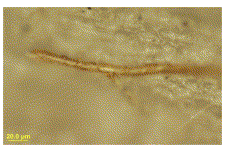Are osseous artefacts a window to perishable material culture? Implications of an unusually complex bone tool from the Late Pleistocene of East Timor
S. O'Connor , G. Robertson , K.P. Aplin
Source - http://www.sciencedirect.com/science/article/pii/S0047248413002467
Journal of Human Evolution
Abstract
We report the discovery of an unusually complex and regionally unique bone artefact in a Late Pleistocene archaeological assemblage (c. 35 ka [thousands of years ago]) from the site of Matja Kuru 2 on the island of Timor, in Wallacea. The artefact is interpreted as the broken butt of a formerly hafted projectile point, and it preserves evidence of a complex hafting mechanism including insertion into a shaped or split shaft, a complex pattern of binding including lateral stabilization of the cordage within a bilateral series of notches, and the application of mastic at several stages in the hafting process. The artefact provides the earliest direct evidence for the use of this combination of hafting technologies in the wider region of Southeast Asia, Wallacea, Melanesia and Australasia, and is morphologically unparallelled in deposits of any age. By contrast, it bears a close morphological resemblance to certain bone artefacts from the Middle Stone Age of Africa and South Asia. Examination of ethnographic projectile technology from the region of Melanesia and Australasia shows that all of the technological elements observed in the Matja Kuru 2 artefact were in use historically in the region, including the unusual feature of bilateral notching to stabilize a hafted point. This artefact challenges the notion that complex bone-working and hafting technologies were a relatively late innovation in this part of the world. Moreover, its regional uniqueness encourages us to abandon the perception of bone artefacts as a discrete class of material culture, and to adopt a new interpretative framework in which they are treated as manifestations of a more general class of artefacts that more typically were produced on perishable raw materials including wood.

Figure 1.
Map showing the location of islands and other localities mentioned in the text.

Figure 2.
The MK2 bone artefact: a) outer or cortical surface; b) inner or medullary surface. Details of the notches and tang are shown in slightly oblique close-up views. Scale bar = 10 mm.

Figure 4.
A degraded hair shaft fragment retained within a vascular groove on the inner surface of the artefact.

Figure 5.
Two possible hafting methods for the MK2 artefact, each consistent with its morphological features and indications of hafting cordage. In both cases, the shape of the project point is conjectural. Mastic is not shown but this would have encased the haft to provide extra mechanical support. In a) the point is bound against the side of a shaft, probably bearing a facet or notch to receive the tang. In b) the point is inserted into a split hollow shaft (e.g., a bamboo culm) with the tang probably pushed into a hollow prepared in the nodal tissue. Under this method, to account for cordage marks on the tang, the artefact must have been bound to one side of the split shaft, prior to the external binding to hold the shaft together.

Figure 6.
Comparison of the MK2 bone artefact (left) with one of the Katanda bone points (right) (Kt9:7B; redrawn from illustration inBaquedano, 2007:97).